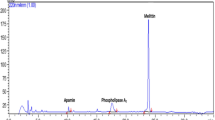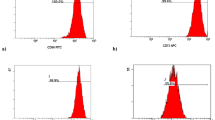Abstract
Purpose
The present study aimed to evaluate the anticancer potential of Egyptian scorpion Leiurus quinquestriatus venom (ScV) or human Wharton’s jelly-derived mesenchymal stem cells conditioning medium (hWJ-MSCs-CM)/CM against breast cancer (MCF-7) cell line as an alternative effective cancer biotherapy.
Methods
Venom (ScV) toxicity was performed recording concentration-dependent viability % and ScV IC50 value was in the order of 100 μg/ml. MCF-7 were treated with hWJ-MSCs-CM used as (25%, 50%, and 75% ml) or the IC50 of ScV. Apoptotic activity was traced via evaluation the apoptotic (Bax, Casp-3, and Casp-9) and anti-apoptotic genes (Bcl2, ALDOA, and PKM2) profile.
Results
Both Bax and Casp-3 showed a significant upregulation while anti-apoptotic genes were significantly downregulated. In the meantime, Casp-3 and Casp-9 protein were monitored using ELISA, and their level was less than in control. Additionally, MCF-7 apoptosis was monitored using flow cytometry recording a significant DNA accumulation in the G0–G1 and S phases in case of cell treatment with ScV or CM75% ml and 50% ml. Also, there was a significant total necrotic cells % compared with control cells, and total apoptosis under the effect of ScV or CM75% ml was significantly elevated than rest of treatment.
Conclusion
Apoptosis induction was both dose- and time-dependent for hWJ-MSCs-CM and ScV. According to the present study and other studies, there is an ample evidence that hWJ-MSCs-CM and the venom IC50 abolish tumor growth.







Similar content being viewed by others
References
Fong CY, Tam K, Cheyyatraivendran S, Gan SU, Gauthaman K, Armugam A, Jeyaseelan K, Choolani M, Biswas A, Bongso A. Human Wharton’s jelly stem cells and its conditioned medium enhance healing of excisional and diabetic wounds. J Cell Biochem. 2014;115:290–302. https://doi.org/10.1002/jcb.24661.
Das Gupta S, Debnath A, Saha A, Giri B, Tripathi G, Vedasiromoni JR, Gomes A, Gomes A. Indian black scorpion (Heterometrus bengalensis Koch) venom induced antiproliferative and apoptogenic activity against human leukemic cell lines U937 and K562. Leuk Res. 2007;31:817–25. https://doi.org/10.1016/j.leukres.2006.06.004.
Mokarizadeh A, Delirezh N, Morshedi A, Mosayebi G, Farshid AA, Dalir-Naghadeh B. Phenotypic modulation of auto-reactive cells by insertion of tolerogenic molecules via MSC-derived exosomes. Vet Res Forum. 2012;3:257–61.
Koç ON, Gerson SL, Cooper BW, Dyhouse SM, Haynesworth SE, Caplan AI, Lazarus HM. Rapid hematopoietic recovery after coinfusion of autologous-blood stem cells and culture-expanded marrow mesenchymal stem cells in advanced breast cancer patients receiving high-dose chemotherapy. J Clin Oncol. 2000;18:307–16. https://doi.org/10.1200/JCO.2000.18.2.307.
Lv Y-G, Yu F, Yao Q, Chen J-H, Wang L. The role of survivin in diagnosis, prognosis and treatment of breast cancer. J Thorac Dis. 2010;2:100–10.
Reed JC. Dysregulation of apoptosis in cancer. J Clin Oncol. 1999;17:2941–53. https://doi.org/10.1200/JCO.1999.17.9.2941.
Krajewski S, Krajewska M, Turner BC, Pratt C, Howard B, Zapata JM, Frenkel V, Robertson S, Ionov Y, Yamamoto H, Perucho M, Takayama S, Reed JC. Prognostic significance of apoptosis regulators in breast cancer. Endocr Relat Cancer. 1999;6:29–40. https://doi.org/10.1677/erc.0.0060029.
Tamm I, Schriever F, Dörken B. Apoptosis: implications of basic research for clinical oncology. Lancet Oncol. 2001;2:33–42. https://doi.org/10.1677/erc.0.0060029.
Dang CV, Semenza GL. Oncogenic alterations of metabolism. Trends Biochem Sci. 1999;24:68–72. https://doi.org/10.1016/s0968-0004(98)01344-9.
Hugosson J, Stranne J, Carlsson SV. Radical retropubic prostatectomy: a review of outcomes and side-effects. Acta Oncol. 2011;1:92–7. https://doi.org/10.3109/0284186X.2010.535848.
Ruysscher De D1, Van Meerbeeck J, Vandecasteele K, Oberije C, Pijls M, Dingemans AM, Reymen B, van Baardwijk A, Wanders R, Lammering G, Lambin P, De Neve W,. Radiation-induced oesophagitis in lung cancer patients. Is susceptibility for neutropenia a risk factor?. Strahlenther Onkol. 2012;188:564–7. https://doi.org/10.1007/s00066-012-0098-z.
Chao KC, Yang HT, Chen MW. Human umbilical cord mesenchymal stem cells suppress breast cancer tumourigenesis through direct cell-cell contact and internalization. J Cell Mol Med. 2012;16:1803–15. https://doi.org/10.1111/j.1582-4934.2011.01459.x.
Baksh D, Yao R, Tuan RS. Comparison of proliferative and multilineage differentiation potential of human mesenchymal stem cells derived from umbilical cord and bone marrow. Stem Cells. 2007;25:1384–1392. https://doi.org/10.1634/stemcells.2006-0709.
Ding J, Chua PJ, Bay BH, Gopalakrishnakone P. Scorpion venoms as a potential source of novel cancer therapeutic compounds. Exp Biol Med. 2004;239:387–393. https://doi.org/10.1177/1535370213513991.
Omran MA. In vitro anticancer effect of scorpion Leiurus quinquestriatus and Egyptian cobra venom on human breast and prostate cancer cell lines. J Med Sci. 2003;3:66–86. https://doi.org/10.3923/jms.2003.66.86.
Abd El-Aziz FE, Shehaby DM, Elghazally SA, Hetta HF. Toxicological and epidemiological studies of scorpion sting cases and morphological characterization of scorpions (Leiurus quinquestriatus and Androctonus crassicauda) in Luxor. Egypt Toxicology Reports. 2019;8:329–35.
Stockert JC, Horobin RW, Colombo LL, Blázquez-Castro A. Tetrazolium salts and formazan products in Cell Biology: viability assessment, fluorescence imaging, and labeling perspectives. Acta Histochem. 2018;120:159–67. https://doi.org/10.1016/j.acthis.2018.02.005.
Gilbert JR, Vance JM. Isolation of genomic DNA from mammalian cells. Curr protocolsin Human Gen. 2001;19:A.3B.1-A.3B.6 https://doi.org/10.1002/0471142905.hga03bs19.
Tamura M, Kawabata A, Ohta N, Uppalapati L, Becker KG, Troyer D. Wharton’s jelly stem cells as agents for cancer therapy. Open Tiss Eng Reg Med J. 2011;4:39–47.
Clarke MR, Imhoff FM, Baird SK. Mesenchymal stem cells inhibit breast cancer cell migration and invasion through secretion of tissue inhibitor of metalloproteinase-1 and -2. Mol Carcinog. 2015;54:1214–1219. https://doi.org/10.1002/mc.22178.
Khakoo AY, Pati S, Anderson SA, Reid W, Elshal MF, Rovira II, Nguyen AT, Malide D, Combs CA, Hall G, Zhang J, Raffeld M, Rogers TB, Stetler-Stevenson W, Frank JA, Reitz M, Finkel T. Human mesenchymal stem cells exert potent antitumorigenic effects in a model of Kaposi's sarcoma. J Exp Med. 2006;203:1235–1247. https://doi.org/10.1084/jem.20051921.
Seyedian R, Pipelzadeh MH, Jalali A, et al. Enzymatic analysis of Hemiscorpius lepturus scorpion venom using zymography and venom-specific antivenin. Toxicon. 2010;56:521–5.
Zhang YY, Wu LC, Wang ZP, et al. Anti-proliferation effect of polypeptide extracted from scorpion venom on human prostate cancer cells in vitro. J Clin Med Res. 2009;1:24–31.
Brazón J, Guerrero B, D’Suze G, Sevcik C, Arocha-Piñango CL. Fibrin(ogen)olytic enzymes in scorpion (Tityus discrepans) venom. Comp Biochem Physiol B Biochem Mol Biol. 2014;168:62–9.
Al-Asmari AK, Islam M, Al-Zahrani AM. In vitro analysis of the anticancer properties of Leiurus quinquestriatus venom in colorectal and breast cancer cell lines. Oncol Lett. 2016;2:1256–62.
Islam M, Datta J, Lang JC, Teknos TN. Down regulation of RhoC by microRNA-138 results in de-activation of FAK, Src and Erk1/2 signaling pathway in head and neck squamous cell carcinoma. Oral Oncol. 2014;50:448–56.
Islam M, Sharma S, Kumar B, Teknos TN. Atorvastatin inhibits RhoC function and limits head and neck cancer metastasis. Oral Oncol. 2013;49:778–86.
Zargan J, Sajad M, Umar S, Naime M, Ali S, Khan HA. Scorpion (Odontobuthus doriae) venom induces apoptosis and inhibits DNA synthesis in human neuroblastoma cells. Mol Cell Biochem. 2011;348:173–81.
Alexander BM, Pinnell N, Wen PY, D’Andrea A. Targeting DNA repair and the cell cycle in glioblastoma. J Neurooncol. 2012;107:463–77.
Gauthaman K, Yee FC, Cheyyatraivendran S, Biswas A, Choolani M, Bongso A. Human umbilical cord Wharton’s jelly stem cell (hWJSC) extracts inhibit cancer cell growth in vitro. J Cell Biochem. 2012;113:2027–39.
Qiao L, Xu Z, Zhao T, Zhao Z, Shi M, Zhao RC, Ye L, Zhang X. Suppression of tumorigenesis by human mesenchymal stem cells in a hepatoma model. Cell Res. 2008;18:500–7. https://doi.org/10.1038/cr.2008.40.
Angelucci S, Marchisio M, Di Giuseppe F, Pierdomenico L, Sulpizio M, Eleuterio E, Lanuti P, Sabatino G, Miscia S, Di Ilio C. Proteome analysis of human Wharton’s jelly cells during in vitro expansion. Proteome Sci. 2010;8:1–12. https://doi.org/10.1186/1477-5956-8-18.
Friedman R, Betancur M, Boissel L, Tuncer H, Cetrulo C, Klingemann H. Umbilical cord mesenchymal stem cells: adjuvants for human cell transplantation. Biol Blood Marrow Transplant. 2007;13:1477–86.
Fong CY, Subramanian A, Gauthaman K, Venugopal J, Biswas A, Ramakrishna S, Bongso A. Human umbilical cord Wharton's jelly stem cells undergo enhanced chondrogenic differentiation when grown on nanofibrous scaffolds and in a sequential two-stage culture medium environment. Stem Cell Rev Rep. 2012;8:195–209. https://doi.org/10.1007/s12015-011-9289-8.
Moodley Y, Atienza D, Manuelpillai U, Samuel CS, Tchongue J, Ilancheran S, Boyd R, Trounson A. Human umbilical cord mesenchymal stem cells reduce fibrosis of bleomycin-induced lung injury. Am J Pathol. 2009;175:303–13. https://doi.org/10.2353/ajpath.2009.080629.
Rhee KJ, Lee JI, Eom YW. Mesenchymal stem cell-mediated effects of tumor support or suppression. Int J Mol Sci. 2015;16:30015–33.
Aggarwal S, Pittenger MF. Human mesenchymal stem cells modulate allogeneic immune cell responses. 2005;105:1815–22.
Fong CY, Chak LL, Biswas A, Tan JH, Gauthaman K, Chan WK, Bongso A. Human Wharton’s jelly stem cells have unique transcriptome profiles compared to human embryonic stem cells and other mesenchymal stem cells. Stem Cell Rev Rep. 2011;7:1–16. https://doi.org/10.1007/s12015-010-9166-x.
Ganta C, Chiyo D, Ayuzawa R, Rachakatla R, Pyle M, Andrews G, Weiss M, Tamura M, Troyer D. Rat umbilical cord stem cells completely abolish rat mammary carcinomas with no evidence of metastasis or recurrence 100 days post-tumor cell inoculation. Cancer Res. 2009;69:1815–1820. https://doi.org/10.1158/0008-5472.
Ayuzawa R, Doi C, Rachakatla RS, Pyle MM, Maurya DK, Troyer D, Tamura M. Naïve human umbilical cord matrix derived stem cells significantly attenuate growth of human breast cancer cells in vitro and in vivo. Cancer Lett. 2009;280:31–37. https://doi.org/10.1016/j.canlet.2009.02.011.
Lew CR, Tolan DR. Targeting of several glycolytic enzymes using RNA interference reveals aldolase affects cancer cell proliferation through a non-glycolytic mechanism. J Biol Chem. 2012;287:42554–63.
Taranger CK, Noer A, Sørensen AL, Håkelien AM, Boquest AC, Collas P. Induction of dedifferentiation, genomewide transcriptional programming, and epigenetic reprogramming by extracts of carcinoma and embryonic stem cells. Mol Biol Cell. 2005;16:5719–35.
Hadjiloucas I, Gilmore AP, Bundred NJ, Streuli CH. Assessment of apoptosis in human breast tissue using an antibody against the active form of caspase 3: relation to tumour histopathological characteristics. Br J Cancer. 2001;85:1522–6.
Salem ML, Shoukry NM, Teleb WK, Abdel-Daim MM, Abdel-Rahman MA. In vitro and in vivo antitumor effects of the Egyptian scorpion Androctonus amoreuxi venom in an Ehrlich ascites tumor model. Springerplus. 2016;5:1–12.
Zargan J, Umar S, Sajad M, Naime M, Ali S, Khan HA. Scorpion venom (Odontobuthus doriae) induces apoptosis by depolarization of mitochondria and reduces S-phase population in human breast cancer cells (MCF-7). Toxicol In Vitro. 2011;25:1748–56.
Widowati W, Wijaya L, Murti H, et al. Conditioned medium from normoxia (WJMSCs-norCM) and hypoxia-treated WJMSCs (WJMSCs-hypoCM) in inhibiting cancer cell proliferation. Biomarkers and Genomic Medicine. 2015;7:8–17.
Vakkala M, Pääkkö P, Soini Y. Expression of caspases 3, 6 and 8 is increased in parallel with apoptosis and histological aggressiveness of the breast lesion. Br J Cancer. 1999;81:592–9.
Acknowledgements
We thank Dr. Khaled M. Said, Regional Market Research Director at DeepDive MEA-Middle East Africa, for his valuable support in all molecular data analysis, and special thanks to Mrs. Fawzia Gaber for her valuable efforts.
Author information
Authors and Affiliations
Contributions
Prof. Dr. Aly Fahmy Mohamed and Prof. Dr. Nadia E. A. El-Gamel contributed the experimental design and manuscript equally. All authors approved the final version of the manuscript. Prof. Dr. Aly Fahmy Mohamed and Yasmen Mohamed Said take responsibility for the integrity of the work and data analysis.
Corresponding author
Ethics declarations
Ethical Approval
hWJ-MSCs were derived from a human umbilical cord donated by a patient after ethical approval and consent signature.
Conflict of Interest
The authors declare no competing interests.
Additional information
Publisher's Note
Springer Nature remains neutral with regard to jurisdictional claims in published maps and institutional affiliations.
Rights and permissions
About this article
Cite this article
Said, Y.M., El-Gamel, N.E.A., Ali, S.A. et al. Evaluation of Human Wharton’s Jelly-Derived Mesenchymal Stem Cells Conditioning Medium (hWJ-MSCs-CM) or Scorpion Venom Breast Cancer Cell Line In Vitro. J Gastrointest Canc 53, 888–901 (2022). https://doi.org/10.1007/s12029-021-00762-3
Accepted:
Published:
Issue Date:
DOI: https://doi.org/10.1007/s12029-021-00762-3




